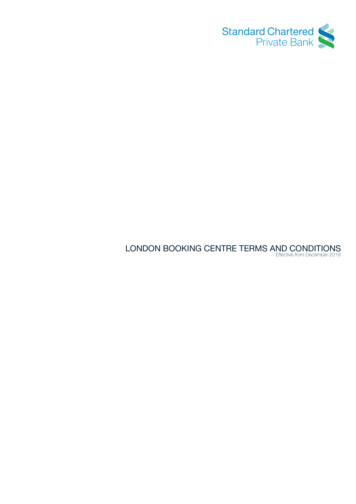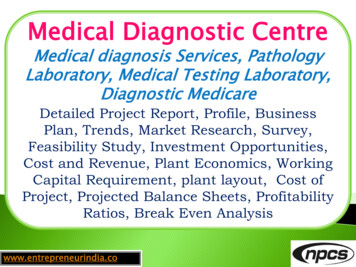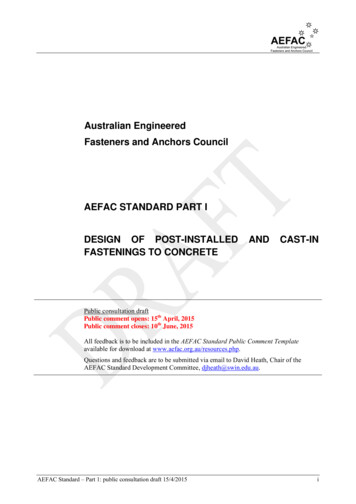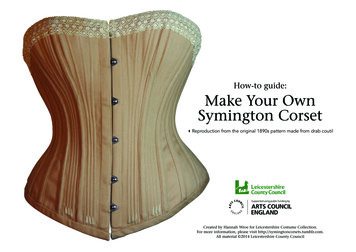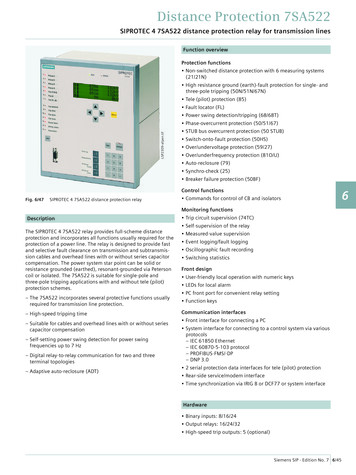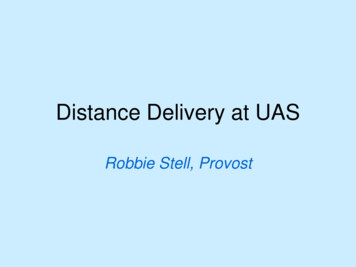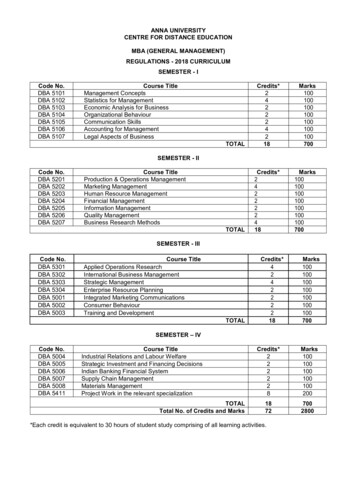
Transcription
ANNA UNIVERSITYCENTRE FOR DISTANCE EDUCATIONMBA (GENERAL MANAGEMENT)REGULATIONS - 2018 CURRICULUMSEMESTER - ICode No.DBA 5101DBA 5102DBA 5103DBA 5104DBA 5105DBA 5106DBA 5107Course TitleManagement ConceptsStatistics for ManagementEconomic Analysis for BusinessOrganizational BehaviourCommunication SkillsAccounting for ManagementLegal Aspects of 0100100700SEMESTER - IICode No.DBA 5201DBA 5202DBA 5203DBA 5204DBA 5205DBA 5206DBA 5207Course TitleProduction & Operations ManagementMarketing ManagementHuman Resource ManagementFinancial ManagementInformation ManagementQuality ManagementBusiness Research MethodsSEMESTER - IIICode No.DBA 5301DBA 5302DBA 5303DBA 5304DBA 5001DBA 5002DBA 5003Course TitleApplied Operations ResearchInternational Business ManagementStrategic ManagementEnterprise Resource PlanningIntegrated Marketing CommunicationsConsumer BehaviourTraining and 100100100700SEMESTER – IVCode No.DBA 5004DBA 5005DBA 5006DBA 5007DBA 5008DBA 5411Course TitleIndustrial Relations and Labour WelfareStrategic Investment and Financing DecisionsIndian Banking Financial SystemSupply Chain ManagementMaterials ManagementProject Work in the relevant specializationTOTALTotal No. of Credits and MarksCredits*2222281872*Each credit is equivalent to 30 hours of student study comprising of all learning activities.Marks1001001001001002007002800
MBA (TECHNOLOGY MANAGEMENT)REGULATIONS - 2018 CURRICULUMSEMESTER - ICode No.DBA 5101DBA 5102DBA 5103DBA 5104DBA 5105DBA 5106DBA 5107Course TitleManagement ConceptsStatistics for ManagementEconomic Analysis for BusinessOrganizational BehaviourCommunication SkillsAccounting for ManagementLegal Aspects of 0100100700SEMESTER - IICode No.DBA 5201DBA 5202DBA 5203DBA 5204DBA 5205DBA 5206DBA 5207Course TitleProduction & Operations ManagementMarketing ManagementHuman Resource ManagementFinancial ManagementInformation ManagementQuality ManagementBusiness Research MethodsSEMESTER - IIICode No.DBA 5301DBA 5302DBA 5303DBA 5304DBA 5011DBA 5012DBA 5013Course TitleApplied Operations ResearchInternational Business ManagementStrategic ManagementEnterprise Resource PlanningTechnology Forecasting and AssessmentTechnology Commercialization & TransferResearch & Development ManagementTOTALCredits*424222218TOTALTotal No. of Credits and 00SEMESTER – IVCode NoDBA 5014DBA 5015DBA 5016DBA 5017DBA 5018DBA 5411Course TitleIntellectual Property RightsManaging Technological InnovationE-Business ManagementSoftware Project & Quality ManagementData Mining & Business IntelligenceProject Work in the relevant specialization*Each credit is equivalent to 30 hours of student study comprising of all learning activities.Marks1001001001001002007002800
MBA (MARKETING MANAGEMENT)REGULATIONS - 2018 CURRICULUMSEMESTER - ICode No.DBA 5101DBA 5102DBA 5103DBA 5104DBA 5105DBA 5106DBA 5107Course TitleManagement ConceptsStatistics for ManagementEconomic Analysis for BusinessOrganizational BehaviourCommunication SkillsAccounting for ManagementLegal Aspects of 0100100700TOTALCredits*424222218TOTALTotal No. of Credits and MarksCredits*2222281872SEMESTER - IICode No.DBA 5201DBA 5202DBA 5203DBA 5204DBA 5205DBA 5206DBA 5207Course TitleProduction & Operations ManagementMarketing ManagementHuman Resource ManagementFinancial ManagementInformation ManagementQuality ManagementBusiness Research MethodsSEMESTER - IIICode No.DBA 5301DBA 5302DBA 5303DBA 5304DBA 5061DBA 5062DBA 5063Course TitleApplied Operations ResearchInternational Business ManagementStrategic ManagementEnterprise Resource PlanningMarketing ResearchBrand ManagementRetail ManagementMarks100100100100100100100700SEMESTER – IVCode NoDBA 5064DBA 5001DBA 5002DBA 5065DBA 5066DBA 5411Course TitleServices MarketingIntegrated Marketing CommunicationsConsumer BehaviourCustomer Relationship ManagementMarketing AnalyticsProject Work in the relevant specialization*Each credit is equivalent to 30 hours of student study comprising of all learning activities.Marks1001001001001002007002800
MBA (HUMAN RESOURCE MANAGEMENT)REGULATIONS - 2018 CURRICULUMSEMESTER - ICode No.DBA 5101DBA 5102DBA 5103DBA 5104DBA 5105DBA 5106DBA 5107Course TitleManagement ConceptsStatistics for ManagementEconomic Analysis for BusinessOrganizational BehaviourCommunication SkillsAccounting for ManagementLegal Aspects of 0100100700TOTALCredits*424222218TOTALTotal No. of Credits and MarksCredits*2222281872SEMESTER - IICode No.DBA 5201DBA 5202DBA 5203DBA 5204DBA 5205DBA 5206DBA 5207Course TitleProduction & Operations ManagementMarketing ManagementHuman Resource ManagementFinancial ManagementInformation ManagementQuality ManagementBusiness Research MethodsSEMESTER - IIICode No.DBA 5301DBA 5302DBA 5303DBA 5304DBA 5021DBA 5022DBA 5023Course TitleApplied Operations ResearchInternational Business ManagementStrategic ManagementEnterprise Resource PlanningManagerial Behaviour and EffectivenessStrategic HRM & DevelopmentPerformance ManagementMarks100100100100100100100700SEMESTER – IVCode NoDBA 5003DBA 5004DBA 5024DBA 5025DBA 5026DBA 5411Course TitleTraining and DevelopmentIndustrial Relations and Labour WelfareOrganizational Theory, Design and DevelopmentSocial PsychologyStress ManagementProject Work in the relevant specialization*Each credit is equivalent to 30 hours of student study comprising of all learning activities.Marks1001001001001002007002800
MBA (FINANCIAL SERVICES MANAGEMENT)REGULATIONS - 2018 CURRICULUMSEMESTER - ICode No.DBA 5101DBA 5102DBA 5103DBA 5104DBA 5105DBA 5106DBA 5107Course TitleManagement ConceptsStatistics for ManagementEconomic Analysis for BusinessOrganizational BehaviourCommunication SkillsAccounting for ManagementLegal Aspects of 00700SEMESTER - IICode No.DBA 5201DBA 5202DBA 5203DBA 5204DBA 5205DBA 5206DBA 5207Course TitleProduction & Operations ManagementMarketing ManagementHuman Resource ManagementFinancial ManagementInformation ManagementQuality ManagementBusiness Research MethodsTOTALSEMESTER - IIICode No.DBA 5301DBA 5302DBA 5303DBA 5304DBA 5006DBA 5031DBA 5032Course TitleApplied Operations ResearchInternational Business ManagementStrategic ManagementEnterprise Resource PlanningIndian Banking Financial SystemSecurity Analysis and Portfolio ManagementHire Purchasing, Leasing and Venture CapitalTOTALCredits*424222218TOTALTotal No. of Credits and 00SEMESTER – IVCode NoDBA 5033DBA 5034DBA 5035DBA 5005DBA 5036DBA 5411Course TitleInsurance & Risk ManagementInternational Trade FinanceFinancial Derivatives ManagementStrategic Investment and Financing DecisionsEntrepreneurial FinanceProject Work in the relevant specialization*Each credit is equivalent to 30 hours of student study comprising of all learning activities.Marks1001001001001002007002800
MBA (HEALTH SERVICES MANAGEMENT)REGULATIONS - 2018 CURRICULUMSEMESTER - ICode No.DBA 5101DBA 5102DBA 5103DBA 5104DBA 5105DBA 5106DBA 5107Course TitleManagement ConceptsStatistics for ManagementEconomic Analysis for BusinessOrganizational BehaviourCommunication SkillsAccounting for ManagementLegal Aspects of 0100100700SEMESTER - IICode No.DBA 5201DBA 5202DBA 5203DBA 5204DBA 5205DBA 5208DBA 5207Course TitleProduction & Operations ManagementMarketing ManagementHuman Resource ManagementFinancial ManagementInformation ManagementServices Quality ManagementBusiness Research MethodsSEMESTER - IIICode No.DBA 5301DBA 5302DBA 5303DBA 5304DBA 5041DBA 5042DBA 5043Course TitleApplied Operations ResearchInternational Business ManagementStrategic ManagementEnterprise Resource PlanningMaterials Management & Logistics in health careManagement of Health Care ServicesHealth 0100100700SEMESTER – IVCode NoDBA 5044DBA 5045DBA 5046DBA 5047DBA 5048DBA 5411Course TitleLegal Aspects of Health CareInternational Health ManagementMedical Equipment ManagementMedical TourismMedical Waste ManagementProject Work in the relevant specializationTOTALTotal No. of Credits and MarksCredits*2222281872*Each credit is equivalent to 30 hours of student study comprising of all learning activities.Marks1001001001001002007002800
MBA (HOSPITALITY AND TOURISM MANAGEMENT)REGULATIONS - 2018 CURRICULUMSEMESTER - ICode No.DBA 5101DBA 5102DBA 5103DBA 5104DBA 5105DBA 5106DBA 5107Course TitleManagement ConceptsStatistics for ManagementEconomic Analysis for BusinessOrganizational BehaviourCommunication SkillsAccounting for ManagementLegal Aspects of 0100100700SEMESTER - IICode No.DBA 5201DBA 5202DBA 5203DBA 5204DBA 5205DBA 5208DBA 5207Course TitleProduction & Operations ManagementMarketing ManagementHuman Resource ManagementFinancial ManagementInformation ManagementServices Quality ManagementBusiness Research MethodsSEMESTER - IIICode No.DBA 5301DBA 5302DBA 5303DBA 5304DBA 5051DBA 5052DBA 5053Course TitleApplied Operations ResearchInternational Business ManagementStrategic ManagementEnterprise Resource PlanningCulture and EthosRoom Division ManagementTourism and Travel 00100100700SEMESTER – IVCode NoDBA 5054DBA 5055DBA 5056DBA 5057DBA 5058DBA 5411Course TitleFood and Beverage ManagementEvent ManagementFacility and Security ManagementFood Safety and QualityDestination ManagementProject Work in the relevant specializationTOTALTotal No. of Credits and MarksCredits*2222281872*Each credit is equivalent to 30 hours of student study comprising of all learning activities.MBA (OPERATIONS MANAGEMENT)Marks1001001001001002007002800
REGULATIONS - 2018 CURRICULUMSEMESTER - ICode No.DBA 5101DBA 5102DBA 5103DBA 5104DBA 5105DBA 5106DBA 5107Course TitleManagement ConceptsStatistics for ManagementEconomic Analysis for BusinessOrganizational BehaviourCommunication SkillsAccounting for ManagementLegal Aspects of 0100100700SEMESTER - IICode No.DBA 5201DBA 5202DBA 5203DBA 5204DBA 5205DBA 5206DBA 5207Course TitleProduction & Operations ManagementMarketing ManagementHuman Resource ManagementFinancial ManagementInformation ManagementQuality ManagementBusiness Research MethodsSEMESTER - IIICode No.DBA 5301DBA 5302DBA 5303DBA 5304DBA 5007DBA 5071DBA 5072Course TitleApplied Operations ResearchInternational Business ManagementStrategic ManagementEnterprise Resource PlanningSupply Chain ManagementLogistics ManagementProduct Design & 100100100700SEMESTER – IVCode NoDBA 5073DBA 5074DBA 5075DBA 5008DBA 5076DBA 5411Course TitleProject ManagementRobust DesignBusiness Process ManagementMaterials ManagementMaintenance ManagementProject Work in the relevant specializationTOTALTotal No. of Credits and MarksCredits*2222281872*Each credit is equivalent to 30 hours of student study comprising of all learning activities.Marks1001001001001002007002800
REGULATIONS 2018ANNA UNIVERSITYMBA (DISTANCE MODE)REGULATIONS 2018SYLLABUS I, II, III AND IV SEMESTERI and II Semesters are Common to:MBA - General ManagementMBA - Technology ManagementMBA - Marketing ManagementMBA - Human Resource ManagementMBA - Financial Services ManagementMBA - Operations ManagementMBA - Health Services ManagementMBA - Hospitality and Tourism ManagementSEMESTER – IDBA 5101MANAGEMENT CONCEPTSC2M100COURSE OBJECTIVE:The purpose of this course is to expose the student to the basic conceptsof management in order to aid the student in understanding how anorganization functions, and in understanding the complexity and widevariety of issues managers face in today‟s business fi rms.COURSE OUTCOME:Completing this course will make the students knowledgeable on thehistorical, current, and future issues in management.UNIT IINTRODUCTION TO MANAGEMENT - Evolution of Management thoughts –Contribution of Selected Management Thinkers – Various approaches to management –contemporary management practice – Managing in global environment – Managerialfunctions.UNIT IIPLANNING - Importance of planning – Types of planning – decision making process –Approaches to decision making – Decision models – Pay off Matrices – Decision trees –Break Even Analysis.UNIT IIIORGANISING - Departmentation – Span of Control – Delegation – Centralisation andDecen-tralisation – Committees – Line and Staff relationships – Recent trends inorganisation structures.UNIT IVSTAFFING - Process of Recruitment, Selection, Induction Training – Motivation –Leading – Leadership styles and qualities – Communication – process and barriers.UNIT VCONTROLLING - Managements control systems – techniques – Types of control.TEXT BOOKS:1. Stephen P. Robbins and David A. Decenzo, “Fundamentals of Management”, Pearson Education,8th Edition, 2012.2. J.S.Chandan, “Management Concepts and Strategies”, Vikas Publishing House, 2010.REFERENCE BOOKS :1. Tim Hannagan, “Management Concepts and Practices”, Macmillan India Ltd., 5th Edition,2009.
2. Hellriegel, Jackson and Slocum, “Management: A Competency-Based Approach”, SouthWestern, 11th edition, 2007.3. Stewart Black and Lyman W. Porter, “Management – Meeting New Challenges”, Prentice Hall,2000.4. Koontz, “Essentials of Management”, Tata McGraw-Hill, 7th Edition, 2006.5. Bateman Snell, “Management: Competing in the new era”, McGraw-Hill Irwin, 5th Edition,2002.DBA 5102STATISTICS FOR MANAGEMENTC4M100COURSE OBJECTIVE:To understand and communicate statistical fi ndings, to learn to applystatistical tools to solve managerial questions, to learn to critically assessstatistical designs and methods.COURSE OUTCOME:Students will be able to think critically about the data arising inmanagement environments, selecting the best tools to describe, analyze,and xploit this data for decision support.UNIT IPROBABILITY - Basic defi nitions and rules for probability, conditional probability, independent of events, Baye‟s Theorem, random variables, Probability distributions:Binomial, Poisson, Uniform and Normal Distributions.UNIT IISAMPLING DISTRIBUTION AND ESTIMATION - Introduction to sampling distributions,sampling techniques, sampling distribution of mean and proportion, application of centrallimit theorem. Estimation: Point and Interval estimates for population parameters of largesample and small samples, determining the sample size.UNIT IIITESTING OF HYPOTHESIS - Hypothesis testing: one sample and two samples tests formeans and proportions of large samples (z-test), one sample and two sample tests formeans of small samples (t-test), F-test for two sample standard deviations.UNIT IVNON-PARAMETRIC METHODS - Sign test for paired data. Rank sum test: Mann – Whitney U test and Kruskal Wallis test. One sample run test, Rank correlation. Chi-squaretests for independence of attributes and goodness of fit.UNIT VCORRELATION, REGRESSION AND TIME SERIES ANALYSIS - Correlation analysis,estimation of regression line. Time series analysis: Variations in time series, trendanalysis, cyclical variations, seasonal variations and irregular variations.TEXT BOOKS:1. Levin R.I. and Rubin D.S., “Statistics for management”, 7th edition, Prentice Hall of India Pvt.Ltd., New Delhi, 2001.2. Aczel A.D. and Sounderpandian J., “Complete Business Statistics”, 5th edition, Tata McGraw –Hill Publishing Company Ltd., New Delhi, 2009.3. Anderson D.R., Sweeney D.J. and Williams T.A., “Statistics for business and economics”, 8thedition, Thomson (South – Western) Asia Pte. Ltd., Singapore, 2010.REFERENCE BOOKS:1. Levine D.M., Krehbiel T.C. and Berenson M.L., “Business Statistics: A First Course”, PearsonEducation Asia, 2nd edition, New Delhi, 5th Edition, 2009.2. Hooda R.P., “Statistics for Business and Economics”, 2nd edition, Macmillan India Ltd., 2010.3. Morse L.B., “Statistics for Business and Economics”, HarperCollins college Publishers, New York,1994.
DBA 5103ECONOMIC ANALYSIS FOR BUSINESSC2M100COURSE OBJECTIVE:The course is designed to enable the students to make sense of thearray of economic data and events that are surrounded by and to placethose into a logical and consistent framework. It helps to make ownjudgments about the likely consequences of various economic events,including the likely policy response of decision makers.COURSE OUTCOME:At the end of the course the students will be able to identify the majoreconomic problems that may affect an economy and to apply simplemicroeconomic theory to some practical problemsUNIT IINTRODUCTION - The themes of economics – scarcity and effi ciency – threefundamental economic problems – society‟s capability – Production possibility frontiers(PPF) – Productive efficiency Vs economic effi ciency – economic growth & stability –Micro economies and Macro economies – the role of markets and government – PositiveVs negative externalities.UNIT IICONSUMER AND PRODUCER BEHAVIOUR - Market –Determinants – Market equilibrium – elasticity of demandbehaviour – consumer equilibrium – Approaches to consumerShort-run and long-run Production Function – Returns todiseconomies of scale – Analysis of cost – Short-run andRelation between Production and cost function.UNIT IIIPRODUCT AND FACTOR MARKET - Product market – perfect and imperfect market –different market structures – Firm‟s equilibrium and supply – Market effi ciency –Economic costs of imperfect competition – factor market – Land, Labour and capital –Demand and supply – determination of factor price – Interaction of product and factormarket – General equilibrium and effi ciency of competitive markets.UNIT IVPERFORMANCE OF AN ECONOMY – MACRO ECONOMICS - Macro-economicaggregates – circular fl ow of macroeconomic activity – National income determination –Aggregate demand and supply – Macroeconomic equilibrium – Components of aggregatedemand and national income – multiplier effect – Demand side management – Fiscalpolicy in theory.UNIT VAGGREGATE SUPPLY AND THE ROLE OF MONEY - Short-run and Long-run supplycurve – Unemployment and its impact – Okun‟s law – Infl ation and the impact – reasonsfor infl ation – Demand Vs Supply factors –Infl ation Vs Unemployment tradeoff – Phillipscurve –short- run and long-run –Supply side Policy and management- Money marketDemand and supply of money – money-market equilibrium and national income – the roleof monetary policyDemand and Supply –and supply – consumerbehaviour – Production –scale – economies Vslong-run cost function –TEXT BOOKS:1.2.3.4.Paul A. Samuelson and William D. Nordhaus, “Economics”, 19th edition, Tata McGraw Hill, 2006.William Boyes and Michael Melvin, “Textbook of economics”, Biztantra, 2007.N. Gregory Mankiw, “Principles of Economics”, 6th edition, Thomson learning, New Delhi, 2011.Richard Lipsey and Alee Charystal, “Economics”, 12th edition, Oxford University Press, NewDelhi, 2011.5. Karl E. Case and Ray C. fair, “Principles of Economics”, Pearson Education Asia, New Delhi,10th edition, 2011.CMDBA 5104ORGANIZATIONAL BEHAVIOUR2100
COURSE OBJECTIVE:To gain a solid understanding of human behavior in the workplacefrom an individual, group, and organizational perspective andframeworks and tools to effectively analyze and approach variousorganizational situations.COURSE OUTCOME:Students will be able to apply problem solving and critical thinkingabilities to analyze the kinds of choices available for developingalternative organizational behavior approaches in the workplace.UNIT IFOCUS AND PURPOSE - Defi nition, need and importance of organizational behaviour –Nature and scope – Frame work – Organizational behaviour models.UNIT IIINDIVIDUAL BEHAVIOUR - Personality – types – Factors infl uencing personality –Theories – Learning – Types of learners – The learning process – Learning theories –Organizational behaviour modifi cation - Misbehaviour – Types – ManagementIntervention. Emotions - Emotional Labour – Emotional Intelligence – Theories. Attitudes– Characteristics – Components – Formation – Measurement- Values. Perceptions –Importance – Factors infl uencing perception – Interpersonal perception- ImpressionManagement Motivation – importance – Types – Effects on work behavior.UNIT IIIGROUP BEHAVIOUR - Organization structure – Formation – Groups in organizations –Infl uence – Group dynamics – Emergence of informal leaders and working norms –Group decision making techniques – Team building - Interpersonal relations –Communication – Control.UNIT IVLEADERSHIP AND POWER - Meaning – Importance – Leadership styles – Theories –Leaders Vs Managers – Sources of power – Power centers – Power and Politics.UNIT VDYNAMICS OF ORGANIZATIONAL BEHAVIOUR - Organizational culture and climate –Factors affecting organizational climate – Importance. Job satisfaction – Determinants –Measurements – Infl uence on behavior. Organizational change – Importance – StabilityVs Change – Proac-tive Vs Reaction change – the change process – Resistance tochange – Managing change. Stress – Work Stressors – Prevention and Management ofstress – Balancing work and Life. Organizational development – Characteristics –objectives –. Organizational effectiveness.TEXT BOOKS:1. Stephen P. Robins, “Organisational Behavior”, PHI Learning / Pearson Education, 15th edition,2012.2. Fred Luthans, “Organisational Behavior”, McGraw Hill, 12th Edition, 2005.REFERENCE BOOKS:1. Schermerhorn, Hunt and Osborn, “Organisational Behavior”, John Wiley, 12th Edition, 2011.2. Udai Pareek, “Understanding Organisational Behaviour”, 2nd Edition, Oxford Higher Education,2008.3. Mc Shane & Von Glinov, “Organisational Behaviour”, 6th Edition, Tata Mc Graw Hill, 2012.4. Hellrigal, Slocum and Woodman, “Organisational Behavior”, Cengage Learning, 2010.5. Ivancevich, Konopaske & Maheson, “Oranisational Behaviour & Management”, 14th edition, TataMcGraw Hill, 2011.DBA 5105COMMUNICATION SKILLSC2M100
COURSE OBJECTIVE:COURSE OUTCOME:UNIT ITo understand how communication works, and to manage theassumptions more effectively. Helps students communicate effectively,appropriately and clearly in all situations.Students will be able to identify barriers to effective communication andhow to overcome them.COMMUNICATION IN BUSINESS - Systems approach- forms - functions and principlesof communication - management and communication- communication patterns - barriersto communication - interpersonal perception – SWOT analysis -Johari Window Transactional Analysis.UNIT IINON-VERBAL AND INTERCULTURAL COMMUNICATION - Importance of non-verbalcommunication - personal appearance - facial expressions- movement- posture –gestures - eye contact –voice - beliefs and customs- worldview and attitude.UNIT IIIORAL COMMUNICATION - Listening - types and barriers to listening - speaking planning and audience awareness - persuasion- goals - motivation and hierarchy ofneeds - attending and conducting interviews-participating in discussions, debates - andconferences - presentation skills- para-linguistic features -fl uency developmentstrategies.UNIT IVBUSINESS CORRESPONDENCE - Business letter - principles of business writing- memos -e-mails – agendas- minutes- sales letter- enquiries- orders- letters of complaintclaims and adjust-ments- notice and tenders- circulars- letters of application and résumé.UNIT VBUSINESS PROPOSALS AND REPORTS - Project proposals- characteristics andstructure- Project reports – types- characteristics,-structure-Appraisal reports –performance appraisal, product appraisal- Process and mechanics of report writingvisual aids- abstract - executive summary- rec-ommendation writing- defi nition of terms.TEXT BOOKS:1. Lesikar, Raymond V., John D Pettit, and Mary E FlatlyLesikar‟s, “Basic BusinessCommunication”, Tata McGraw-Hill, 11th edition, New Delhi, 2007.2. Gerson, Sharan J., and Steven M Gerson, “Technical Writing: Process and Product”, PearsonEducation, New Delhi, 8th Edition, 2013.3. Murphy, Herta, Herbert W Hildebrandt, and Jane P Thomas, “Effective BusinessCommunication”, 7th ed. Tata McGraw-Hill, New Delhi.4. Bovee, Courtland and John V Thill, “Business Communication Today”, Pearson Education, NewDelhi, 11th edition, 2012.REFERENCE BOOKS:1. McGrath, E. H., S. J, “Basic Managerial Skills for All”, Prentice-Hall of India, New Delhi, 8th ed.2011.2. Raman, Meenakhshi, and Prakash Singh, “Business Communication”, O U P, New Delhi, 2ndEdition, 2012.3. Stuart Bonne E., Marilyn S Sarow and Laurence Stuart, “Integrated Business Communication in aGlobal Market Place”,3rd ed. John Wiley India, New Delhi, 2007.4. Guffey, Mary Ellen., “Business Communication: Process and Product”, Thomson andSouthwestern, 7th edition, 2010.DBA 5106ACCOUNTING FOR MANAGEMENTC4M100
COURSE OBJECTIVE:Students acquire knowledge of internal accounting system, costclassification, cost behavior, cost volume profit analysis, budget andvariance analysis in decision making.COURSE OUTCOME:Students will be able to apply cost relationship for analysis, use costs inpricing and decision making.UNIT IFINANCIAL ACCOUNTING - Introduction to Financial, Cost and ManagementAccounting- Generally accepted accounting principles, Conventions and ConceptsBalance sheet and related concepts- Profi t and Loss account and related concepts Introduction to infl ation accounting- Introduction to human resources accounting.UNIT IICOMPANY ACCOUNTS - Meaning of Company -Maintenance of Books of AccountStatutory Books- Profi t or Loss Prior to incorporation- Final Accounts of Company.Employees stock option- Buy back of securities.UNIT IIIANALYSIS OF FINANCIAL STATEMENTS - Analysis of fi nancial statements –Financial ratio analysis, cash fl ow (as per Accounting Standard 3) and funds fl owstatement analysis.UNIT IVCOST ACCOUNTING - Cost Accounts - Classifi cation of manufacturing costs Accounting for manufacturing costs. Cost Accounting Systems: Job order costing Process costing- Activity Based Costing. Costing and the value chain- Target costing.UNIT VMANAGEMENT ACCOUNTING - Marginal costing including decision making- BudgetaryControl & Variance Analysis - Standard cost system.TEXT BOOKS:1. M.Y.Khan & P.K.Jain, “Management Accounting”, Tata McGraw Hill, 5th edition, 2009.2. R.Narayanaswamy, “Financial Accounting – A managerial perspective”, PHI Learning, New Delhi,4th edition, 2011.REFERENCE BOOKS:1. Jan Williams, “Financial and Managerial Accounting – The basis for business Decisions”, TataMcGraw Hill Publishers, 15th edition, 2011.2. Horngren, Surdem, Stratton, Burgstahler, Schatzberg, “Introduction to Management Accounting”,PHI Learning, 16th edition, 2013.3. Stice & Stice, “Financial Accounting Reporting and Analysis”, Cengage Learning, 11th edition2010.4. Singhvi Bodhanwala, “Management Accounting -Text and cases”, PHI Learning, 2008.5. Ashish K. Battacharya, “Introduction to Financial Statement Analysis”, Elsevier, 2007.DBA 5107LEGAL ASPECTS OF BUSINESSC2M100COURSE OBJECTIVE:To develop an awareness of the legal framework within which businessoperates in India and to give to the students the basic understanding ofsome of the important legal aspects of business.COURSE OUTCOME:Helps students to avoid/resolve legal problems in a variety of businesssituations.
UNIT IMERCANTILE AND COMMERCIAL LAW THE INDIAN CONTRACT ACT 1872 Essential of a valid contract, Void Agreements, Defi nition of contract, Formation of acontract, performance of contracts, breach of contract and its remedies, Quasi contracts.THE SALE OF GOODS ACT 1930 - Sales contract, Transfer of title and risk of loss,Guarantees and Warranties in sales contract, performance of sales contracts, conditionalsales and rights of an unpaid seller.NEGOTIABLE INSTRUMENTS ACT 1881 - Nature and requisites of negotiableinstruments. Transfer of negotiable instruments and liability of parties, enforcement ofsecondary liability, holder in due course, special rules for Cheque and drafts, discharge ofnegotiable instruments.AGENCY - Nature of agency – Creation of agency, types of agents, Agent‟s authority andliability of principal and third party: Rights and duties of principal, agents and Third party,liability of agents torts, termination of agency.UNIT IICOMPANY LAW - Major principles – Nature and types of companies, Formation,Memorandum and Articles of Association, Prospectus, Power, duties and liabilities ofDirectors, winding up of companies, Corporate Governance.UNIT IIIINDUSTRIAL LAW - An Overview of Factories Act, Payment of WagesAct, Payment of Bonus Act, Industrial Disputes Act.UNIT IVINCOME TAX ACT AND SALES TAX ACT - Corporate Tax Planning, Overview ofcentral Sales Tax Act 1956 – Defi nitions, Scope, Incidence of CST, Practical issues ofCST, Value Added Tax – Concepts, Scope, Methods of VAT Calculation, PracticalImplications of VAT.UNIT VCONSUMER PROTECTION ACT AND INTRODUCTION OF CYBER LAWS - ConsumerProtection Act – Consumer rights, Procedures for Consumer grievances redressal, Typesof consumer Redressal Machineries and Forums, Cyber crimes, IT Act 2000 and 2002,Cyber Laws, Introduction of IPR – Copy rights, Trade marks, Patent Act.TEXT BOOKS:1. N. D. Kapoor, “Elements of mercantile Law”, Sultan Chand and Company, India, 2008.2. P. K. Goel, “Business Law for Managers”, Bizentra Publishers, India, 2008.REFERENCE BOOKS:1.2.3.4.P. P. S. Gogna, “Mercantile Law”, S. Chand & Co. Ltd., India, 11th Edition, 2010.Dr. Vinod, K. Singhania, “Direct Taxes Planning and Management”, 2008.Akhileshwar Pathack, “Legal Aspects of Business”, 4
MBA (GENERAL MANAGEMENT) REGULATIONS - 2018 CURRICULUM SEMESTER - I Code No. Course Title Credits* Marks DBA 5101 Management Concepts 2 100 DBA 5102 Statistics for Management 4 100 DBA 5103 Economic Analysis for Business 2 100 DBA 5104 Organizationa



